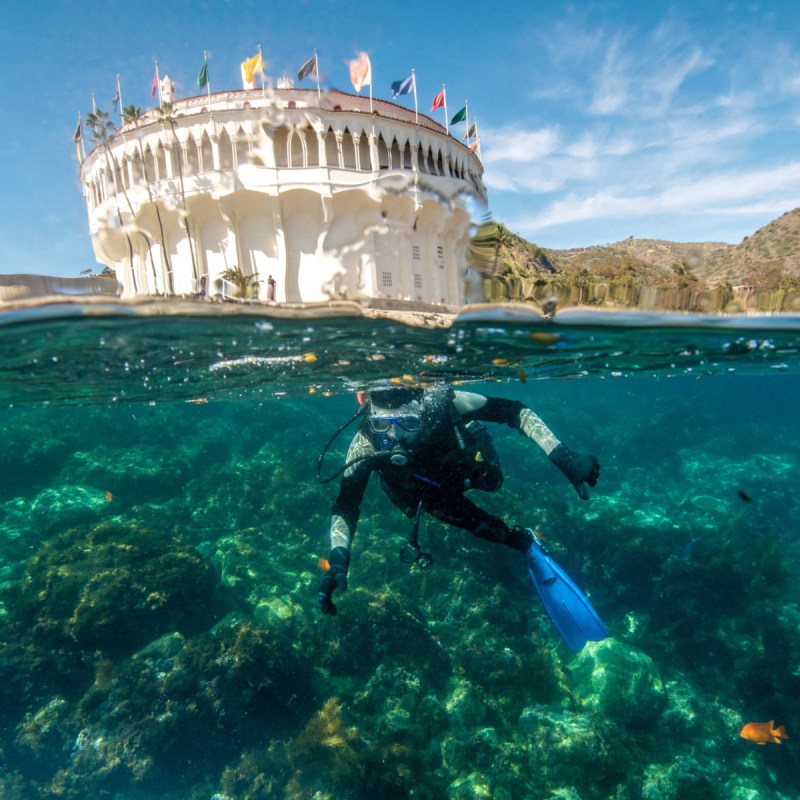
Despite making three trips to Catalina Island in 2 years, my husband Jason and I still aren’t done exploring it. Each time, we’ve discovered new attractions that make us wish we had more time on the island and soon we begin planning our return trip. For our recent visit, our focus was the wild side of the island, often referred to as the backcountry. It’s a lesser-known part of the island, but I hope to change that.
Videos by TravelAwaits
88 percent of Catalina Island is undeveloped and protected thanks to the Catalina Island Conservancy. Hikers, cyclists, campers, and boaters can access 165 miles of recreational roads and trails as well as 62 miles of beaches. All of this protects 60 species of plants, insects, and animals found only on this island. It is also home to 100 bison, brought there in 1924 for the filming of a movie. After the filming was complete, the bison had scattered and the decision was made to leave them on the island.
How To Get To Catalina Island
Before enjoying any of these adventures, you’ll first need to get to Catalina Island. Catalina Express operates daily ferries from San Pedro (Los Angeles), Long Beach, and Dana Point. It’s a quick and comfortable journey of 60 to 90 minutes, and if you’re lucky, you may see dolphins.
A portion of this trip was hosted, but all opinions are my own.

1. Backcountry Eco-Tour
The conservancy’s Eco-Tour is definitely one of my favorite things to do on Catalina Island. Hop aboard and buckle up to explore the backcountry on both paved and dirt roads all while learning about the plants and animals that call the island home. Led by a naturalist, these 3-hour tours go deep into the canyons and then up to the hilltops where guests enjoy expansive views of the Pacific Ocean. Along the way you’ll learn the history of the island, meet some of its furry inhabitants, and discover why it’s so important to protect the land.
Our guide, Shaun, a fourth-generation island resident, was not only knowledgeable but also deeply committed to the conservation of Catalina’s environment. He shared the decades-long effort to protect bald eagles, one of which we were lucky to see soaring high above. After spotting an island fox he told us of the successful effort to protect these cute critters and remove them from the endangered species list. We spotted several tiny, picturesque coves and even stopped for a cookie break at the Airport In The Sky. I would happily take this tour again.

2. Trans Catalina Trail Hiking
Beginning in Avalon and ending 38.5 miles later, the Trans Catalina Trail (known by locals as the TCT) is both physically challenging and visually stunning. Most hikers allow 4 days to complete the trail and camp each night in one of the conservancy-owned campgrounds.
If you’re not ready for a multi-day hike, consider hiking portions of the TCT instead. We had the opportunity to see a short 3-mile stretch called the Airport Loop Trail with Catalina Backcountry. Our guides Sydney and Barry picked us up at our hotel, drove us to the Airport In The Sky, and then led us on an informative and scenic hike. Along the way, we learned how the island was formed, about the Tongva people who originally inhabited it, and what to expect if you’re interested in hiking the full TCT. After the hike, we enjoyed a delicious lunch at DC-3 Grill and then returned to Avalon. This brief introduction to the TCT has definitely inspired us to return soon and explore more of it.
Pro Tip: Hiking anywhere in the interior of the island, including the TCT, does require a permit, which is free of charge. Permits can be obtained on the Conservancy’s website.

3. Mountain Biking
Mountain biking is another popular outdoor adventure in Catalina. While bicycles are not allowed on the TCT, they can access paved and unpaved roads in the backcountry in order to cross the island from Avalon to Two Harbors. The 24-mile route is challenging, so many cyclists opt to do it in 2 days and camp 1 night along the way.
Another option for mountain bikers is to head directly to Two Harbors and enjoy the trails on the west end of the island, an area few people ever see. This does take a fair amount of planning since the ferry schedule to Two Harbors is limited as are the lodging options.
Pro Tip: Biking through the interior of the island requires a Freewheeler Bike Pass, which can be purchased through Catalina Island Conservancy.

4. Dive Or Snorkel In A Marine Protected Area
California has a whopping 124 Marine Protected Areas (MPA), nine of which can be found surrounding Catalina. These federally designated waters protect sensitive marine life and restrict commercial activity. As a result, the marine ecosystems of the island are among the healthiest in the world and make for excellent diving and snorkeling.
Located at the edge of the Catalina Casino building, the Casino Point Marine Park is Southern California’s first city-designated underwater park, and it’s the perfect spot for experienced divers to explore a giant kelp forest and several shipwrecks.
Don’t worry if you’re not a certified diver, snorkeling and snuba are also possible in Catalina. A variety of guided adventures are available through Catalina Divers Supply and Catalina Scuba.

5. Kayaking
It’s possible to explore some of the island’s MPAs without getting submerged. Rent a kayak and start paddling to tiny coves and secluded beaches all while watching the abundant marine life swimming in the water beneath you. While kayaking here, Jason and I have enjoyed seeing a giant kelp forest from above and peering into the clear water to see all kinds of fish. We’ve even been visited by a friendly harbor seal.
If you’re visiting Avalon and are an experienced paddler, simply rent a kayak and get out on the water. For those new to kayaking or wishing for some guidance, consider joining a tour with an experienced guide through Catalina Island Expeditions. If you’re visiting Two Harbors, both kayaks and paddle boards can be rented through Two Harbors Kayak Rental.

6. Undersea Sub Expedition
Even if you don’t swim — or simply don’t want to get wet — there’s still a way to explore Catalina’s waters on an Undersea Sub Expedition. The 45-minute excursion departs from the Green Pleasure Pier in Avalon and slowly moves through the nearby Lover’s Cove, one of the island’s MPAs. As we entered a giant kelp forest, we saw hundreds of fish including dozens of orange garibaldi, the official marine fish of California.
The first mate of the ship feeds the fish a small amount of food to attract them to the vessel, though he assured us that it wasn’t enough to interfere with their normal feeding habits. The experience reminded me of Disney’s famous ride, the Submarine Voyage, though this time with real marine life. If you’re traveling with children, I highly recommend this experience.

7. Backcountry Camping
I’m not usually eager to camp, but a campground on the beach tucked in a secluded cove is just the incentive I need to leave the hotel behind. Campgrounds on Catalina might be some of the most scenic anywhere in the U.S.
The conservancy operates three campgrounds across the island that are often used by TCT hikers. All offer potable water, cold showers, and chemical toilets. Campers may bring all their provisions and gear or opt to rent commonly needed items like sleeping bags and stoves.
Additionally, there are campgrounds near the dock in Two Harbors with either traditional tent sites or tent cabins. These offer potable water, showers, toilets, and a nearby general store.
For something really unique, try kayaking or boating to your campsite. Five boat-in campgrounds are available on the island. These are, however, considered primitive and do not include toilets, showers, or water. All trash and waste must be packed out.
Pro Tip: If you want all the joys of camping without the hassle of lugging gear and setting up camp, consider using a service like Catalina Backcountry to do all of it for you. And if you really want a glamping experience, they will even cater your meals.

Where To Stay In Catalina
If you’re not planning to camp or backpack while on the island, then I recommend staying at the Bellanca Hotel on Crescent Avenue which is Avalon’s main street. This recently refurbished boutique hotel offers unobstructed views of the harbor. We watched the sunset over the harbor while dining at the onsite restaurant, Naughty Fox, and then witnessed a stunning sunrise from our room the next morning. You can splurge and have your own balcony or take advantage of the communal patio for equally great views. The large rooms are perfect for relaxing between adventures and anything you need in Avalon is just a short walk away.
Pro Tip: If you’re coming off-season — especially in the winter — there are good deals to be had that combine the ferry transportation to the island and lodgings.
Related Reading:
